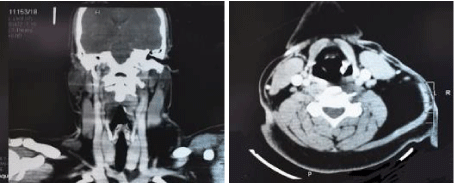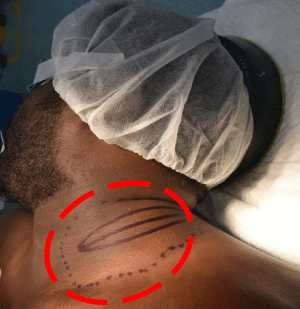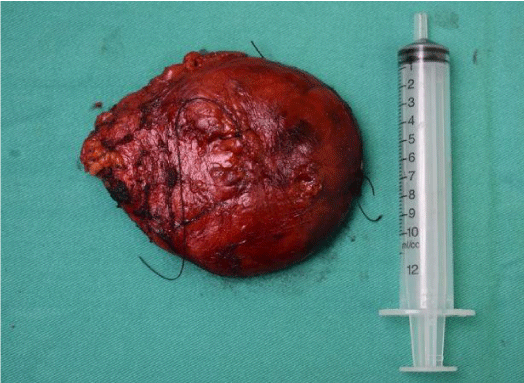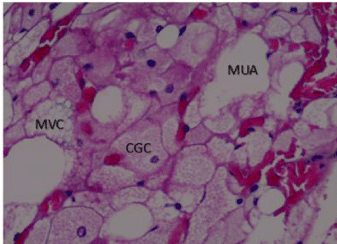Hibernoma: Rare Fetal Adipocytic Tumor in the Neck
Vishnu Varathan Moganadass1*, Ng Jia Ji1, Shashi Gopalan1, Johnson Ng1 and Noorjehan Binti Omar2
1Department of ORL-HNS, Hospital Tengku Ampuan Rahimah, Klang, Selangor, Malaysia
2Department of Pathology, Hospital Tengku Ampuan Rahimah, Klang, Selangor, Malaysia
*Address for Correspondence: Vishnu Varathan, Department of ORL-HNS, Hospital Tengku Ampuan Rahimah, Klang, Selangor, Malaysia, Tel: +601-966-890-65; E-mail: [email protected]
Submitted: 19 July 2019; Approved: 25 July 2019; Published: 29 July 2019
Citation this article: Moganadass VV, Ji NJ, Gopalan S, Johnson Ng, Omar NB. Hibernoma: Rare Fetal Adipocytic Tumor in the Neck. Int J Rhinol Otological. 2019;2(1): 008-010.
Copyright: © 2019 Moganadass VV, et al. This is an open access article distributed under the Creative Commons Attribution License, which permits unrestricted use, distribution, and reproduction in any medium, provided the original work is properly cited
Keywords: Hibernoma; Benign; Brown fat cell tumor; Neck; Lipoma
Download Fulltext PDF
Hibernoma is a rare, painless, and benign soft tissue tumor arising from brown fat cells. We present a 28 year old gentleman with a large and tender left anterior neck swelling associated with restricted left shoulder movement for one week duration after he was involved in a motor vehicle accident. Due to the nature of the injury and presentation, it was unexpected to find a well encapsulated fat density suggestive of lipoma from Computed Tomography (CT) scan. Surgical exploration and excision were performed, and the histopathological examination of the excised mass noted to be hibernoma. Patient recovered well and regained full shoulder movement post operatively. This case illustrated the importance of having broad differentials when approaching patients with post traumatic neck swelling.
Introduction
Hibernoma is a rare, painless and slow growing benign soft tissue tumor arising from brown fat cells. Brown fat cells gradually regresses after eight weeks of age but the remnants deposits in the subcutaneous regions especially thighs, thorax, shoulder, retroperitoneum, head and neck [1]. About 100 cases have been reported in English scientific literature but only 10 cases have described in the head and neck region [2] which is rare especially in the neck region. It accounts for 1.6% of benign lipomatous tumors and about 1.1% of all tumors originating from adipose tissue [3]. We present a rare case of intramuscular hibernoma of the neck region in a 28 years old male.
Case Report
A twenty eight years old male, presented with 1 week duration of pain, increasing swelling and tenderness in his left anterior neck extending to left supraclavicular fossa following a motor vehicle accident and there was no direct impact towards the neck region. However few day post trauma, the swelling over the left supraclavicular region increased in size with tenderness to a sharp pain over the left side of the neck with restricted shoulder movement. Otherwise patient have no stridor, no fever and able to perform his routine activities with limited movement of his left shoulder due to pain.
Physical examination revealed a diffuse, large, tender, intramuscular 10 cm diameter mass over the left supraclavicular region. The mass was fixed, not pulsatile and no surrounding inflammation.
Fine Needle Aspiration for Cytology (FNAC) attempted but was unsatisfactory. Computed Tomography (CT) scan was done which revealed a well encapsulated lesion of fat density seen at the left side of the neck extending to the infraclavicular region measuring approximately 4cmx5cm suggestive intermuscular lipoma and differentials included pseudolipoma (fat necrosis) (Figure 1&2).
Proceeded with Otolaryngology where a well encapsulated hypervascularised mass size 6cmx9cm was excised (Figure 3.1). Histopathological examination revealed a lesion composed of mixture of mature univacoulated adipocytes and coarsely granular to multivacoulated cells (Figure 3) with a definitive diagnosis of hibernoma.
Figure 4 Histopathological Findings: High power view of Coarsely Granular Cells (CGC), Multivacuolated Cells (MVC) and Mature Univacuolated (MUV) adipocytes; Hematoxylin and Eosin staining shows under 20x magnification.
Discussion
Hibernoma is a rare fetal adipocytic tumor originating from brown fat resembling which first described as brown fat tumor by Meckel in 1906, termed Hibernoma by Gery in 1914 [2,3]. Hibernoma mostly seen in 3rd, 4th and 5th decades of life, higher prevalence in female [3].
A clinical study conducted by Furlong et al. total 170 case of patients with hibernoma reported, and the most common location of hibernoma was the thigh (n = 50 case), followed by shoulder (n = 20 cases), back (n = 17 cases), neck (n = 16 cases), chest and arm (n =11 cases each) and retroperiotoneum (n = 10 cases) [2]. This shows hibernoma from neck region is rare. The tumor size of hibernoma basically ranges with average 9.3 cm [2]. The tumor excised from our patient ranging 7 cm.
Patients diagnosed with hibernoma normally presented with slow growing mass, and asymptomatic. From the studies published, trauma associated tumors which mostly reported was lipoma, which called as “pseudolipoma”, which defines a herniation of inner fats through the scarpa layer due to blunt trauma [4]. As far our patient presented with a rapid increasing in neck mass post motor vehicle accident which was tender making us think of an underlying hematoma. However fine needle aspiration was unsatisfactory.
Computed Tomography, Magnetic Resonance Imaging and Angiography provides additional useful information in diagnosing Hibernoma. On CT scan, the lesion appears homogenous with contrast enhancement, lobulated, septated and well encapsulated with fat density. The hibernoma tissue can be differentiated to fats with magnetic resonance imaging [1,4]. In our patient, it shows a mass which very well circumscribed and homogenous. Thus reported in latest literature, some characteristics remains difficult to distinguish with some malignant and rare tumors such as malignant fibrous histocytoma and angliolipoma [3].
The final diagnosis of our case study made after the surgical excision which is from the histopathology of the tumor. Macroscopically, Hibernoma appears yellow to brown on cut surface, with well encapsulated tumor and highly vascularized. Hypervascularization with combined mitochondria gives hibernoma its colour. Cytologically, the smear from hibernoma usually shows round cell with cytoplasmic vacuoles with central round nuclei. This smear cytogically similar with liposarcoma, chondroid lipoma and benign granular cell tumor. The presence of univacoulated and multivacoulated fat cells suggestive of hibernoma. Hematoxylin and eosin used for staining, immunophenotypicaly, hibernomas shows positive s-100 [3,4]. The presence case was an example of labelled as typical hibernoma with histopathological findings of multivacoulated adipose cells more than 70%.
Patient was discharged after 6 months follow up with no local recurrence over the operated area.
Conclusion
Hibernoma is rare fetal adipocytic tumor in neck. Treatment is surgical resection and no reported case of recurrence or malignant transformation have been identified from in the recent studies done.
- Kohler S. Muscle, adipose and cartilage neoplasms. In: Rapini RP, Bolognia JL, Jorizzo JL, editors. Dermatology: 2-
- volume set. 2nd ed. St. Louis, MO: Mosby; 2007. p. 1839e40.
- Chen CL, Chen WC, Chiang JH, Ho CF. Intercapsular hibernoma-Case report and literature review. Kaohsiung J Med Sci. 2011; 27: 348-352. http://bit.ly/2yeGZRU
- Mavrogenis A, Coll Mesa L. Soft tissue: Hibernomas. Atlas Genet Cytogenet Oncol Haematol. 2013; 17: 60-64.
- Carinci F, Carls FP, Pelucchi S, Grandi E, Hassanipour A, Pastore A. Hibernoma of the neck. J Craniofac Surg. 2001; 12: 284-286. http://bit.ly/2KaF9XM
- Trujillo O, Cui IH, Malone M, Suurna M. An unusual presentation of a rare benign tumor in the head and neck: A review of hibernomas. Laryngoscope. 2015; 125: 1656-1659. http://bit.ly/2Ylt7Qu





Sign up for Article Alerts